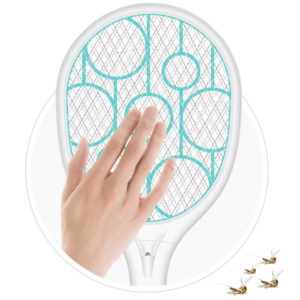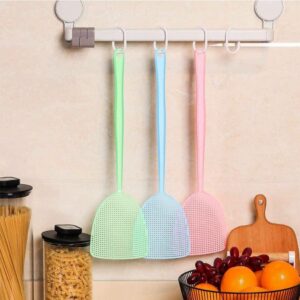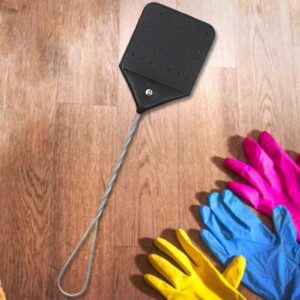The Premier Fly Swat & Electric Fly Swatter
3 DAY MAY SUPER SALE … Don’t Miss Out
-
Sale!

Bug Zapper Racket | Fly Zapper Racket | Tennis Racket Bug Zapper
Original price was: $59.$49Current price is: $49. -
Sale!

Swat Fly Repellent | Swat For Flies | Plastic Fly Swat – x5 Pack
Original price was: $39.$33Current price is: $33. -
Sale!

Leather Fly Swat | Fly Swatter Leather | Leather Swatter
Original price was: $59.$49Current price is: $49.
Mastering the Art of Fly Swatting: Your Comprehensive Guide to the Best Fly Swatters, Electric Fly Swatters, and Bug Zapper Rackets
When it comes to dealing with flying pests like flies, there’s nothing more satisfying than a well-executed swat that puts an end to their annoying presence. That’s where fly swatters come to the rescue. In this comprehensive guide, we’ll dive into the world of fly swatters, exploring the different types available and highlighting the best options for your needs. We’ll also take a closer look at two popular alternatives to traditional swatters: electric fly swatters and bug zapper rackets. Get ready to arm yourself with the knowledge and tools you need to achieve a fly-free environment!
The Fly Swatter: A Classic Tool Reimagined
Fly swatters have been a staple in households for decades, providing a simple yet effective way to combat flying insects. Over time, they have evolved to cater to different preferences and needs. Traditional plastic swatters offer a lightweight and easy-to-use option. They usually feature a plastic handle with a flat, flexible surface, often shaped like a hand or a paddle, to quickly and efficiently swat flies and other bugs. These swatters are affordable, durable, and come in various sizes and colors to suit individual preferences.
Wire mesh swatters take the classic design a step further by incorporating a mesh surface that allows for better airflow and a higher success rate in catching flies. The fine mesh effectively traps insects upon impact, minimizing the chance of them escaping. Wire mesh swatters are often preferred for their increased precision and effectiveness.
Rubber swatters, on the other hand, offer a unique approach with their flexible rubber surface. The rubber material provides a soft and cushioned impact, reducing the chances of leaving marks or damaging surfaces. These swatters are gentle enough to use on delicate materials such as curtains or fabrics while still being effective in catching flies.
When choosing a fly swatter, consider key features such as size, flexibility, grip, and durability. Opt for a swatter that feels comfortable in your hand and has a surface that provides a good balance between flexibility and effectiveness. Additionally, selecting a swatter in a color or design that matches your personal style can add a touch of fun to the task of fly swatting.
The Power of Electric Fly Swatters
Electric fly swatters, also known as bug zappers or electric fly killers, have gained popularity as an alternative to traditional fly swatters. These innovative tools are powered by batteries and feature an electrified grid or grid-like surface that delivers a quick jolt of electricity upon contact with a flying insect.
Electric fly swatters are known for their efficiency and ease of use. When a fly or other insect comes into contact with the electrified surface, it is instantly electrocuted, eliminating the need for manual swatting. These swatters often come with a button or switch that activates the electric grid, ensuring safety when not in use.
One of the advantages of electric fly swatters is their ability to reach insects in mid-air, making them useful for targeting fast-flying or hard-to-reach bugs. They are also effective against a wide range of flying insects, including mosquitoes, gnats, and wasps. Electric fly swatters are particularly popular for outdoor use, such as during picnics, camping trips, or barbecues, where flies and bugs can be a nuisance.
However, it’s important to note that electric fly swatters should be used with caution, especially around children and pets. While they are generally safe when handled properly, it’s crucial to follow the manufacturer’s instructions and keep them out of reach when not in use. Additionally, electric fly swatters may not be suitable for use on delicate surfaces or fabrics due to the possibility of leaving marks or causing damage.
When selecting an electric fly swatter, consider factors such as battery life, voltage, and safety features. Look for swatters with a durable construction and a powerful electric grid to ensure effectiveness. It’s also beneficial to choose a swatter with a comfortable grip and a design that allows for easy cleaning and maintenance.
Exploring Bug Zapper Rackets
Bug zapper rackets offer another alternative to traditional fly swatters. These innovative tools combine the functions of a fly swatter and a bug zapper, creating a handheld racket-shaped device that delivers an electric shock to flying insects upon contact.
Bug zapper rackets work by utilizing an electrified grid or grid-like surface, similar to electric fly swatters. When activated, the racket generates an electric field that instantly kills flying insects upon contact, making it a convenient and effective method for insect control.
One of the key advantages of bug zapper rackets is their versatility. They can be used both indoors and outdoors, allowing you to tackle flies and other flying pests wherever they may be. Bug zapper rackets are particularly useful for large and aggressive insects, such as wasps or hornets, which may require a more powerful and immediate solution.
When choosing a bug zapper racket, consider factors such as voltage, size, and safety features. Look for a racket with a durable construction that can withstand repeated use and ensure safety during operation. It’s also helpful to select a model with a comfortable grip and a large surface area for better coverage and increased chances of successfully zapping insects.
Remember to exercise caution when using bug zapper rackets, especially around children and pets. Follow the manufacturer’s instructions and avoid touching the electrified grid to prevent accidental shocks.
Conclusion:
Fly swatters, electric fly swatters, and bug zapper rackets offer a range of options for effectively dealing with flying insects. Traditional fly swatters provide a classic and affordable solution, while electric fly swatters and bug zapper rackets offer innovative and efficient alternatives. When selecting a fly swatter, consider factors such as the type of swatter, material, flexibility, and grip. Electric fly swatters provide a quick and convenient way to eliminate flying insects with the power of electricity, while bug zapper rackets combine the functionalities of a fly swatter and a bug zapper for added versatility. By choosing the right tool for your needs, you can master the art of fly swatting and enjoy a fly-free environment.
